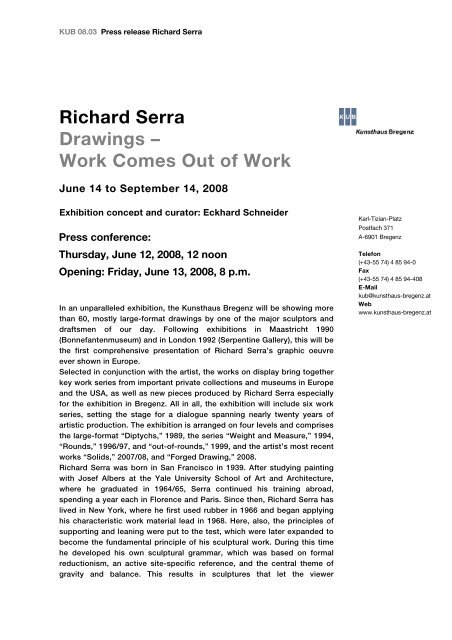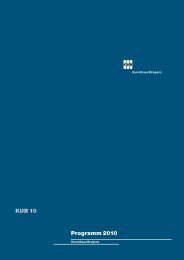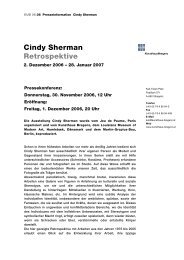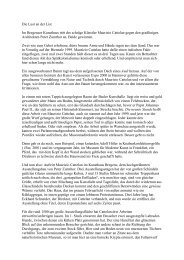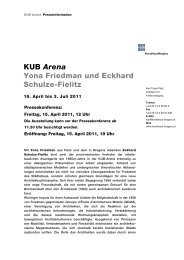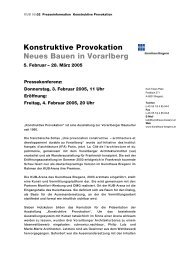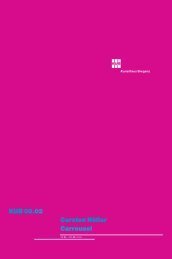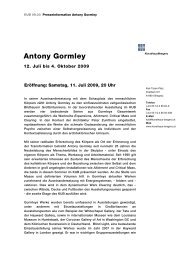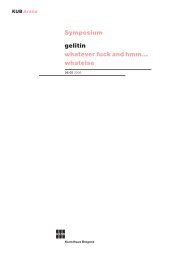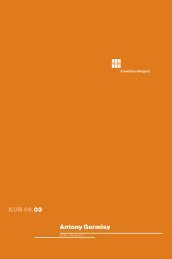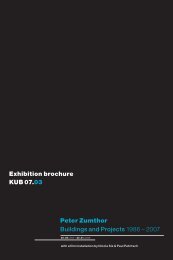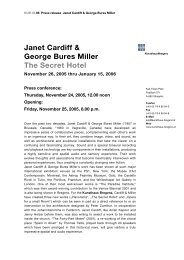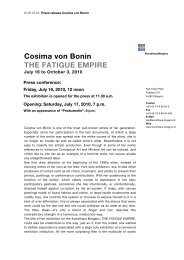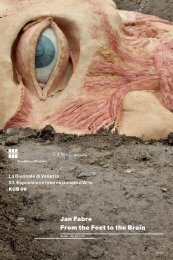Richard Serra Drawings – Work Comes Out of Work
Richard Serra Drawings – Work Comes Out of Work
Richard Serra Drawings – Work Comes Out of Work
You also want an ePaper? Increase the reach of your titles
YUMPU automatically turns print PDFs into web optimized ePapers that Google loves.
KUB 08.03 Press release <strong>Richard</strong> <strong>Serra</strong><br />
<strong>Richard</strong> <strong>Serra</strong><br />
<strong>Drawings</strong> <strong>–</strong><br />
<strong>Work</strong> <strong>Comes</strong> <strong>Out</strong> <strong>of</strong> <strong>Work</strong><br />
June 14 to September 14, 2008<br />
Exhibition concept and curator: Eckhard Schneider<br />
Press conference:<br />
Thursday, June 12, 2008, 12 noon<br />
Opening: Friday, June 13, 2008, 8 p.m.<br />
In an unparalleled exhibition, the Kunsthaus Bregenz will be showing more<br />
than 60, mostly large-format drawings by one <strong>of</strong> the major sculptors and<br />
draftsmen <strong>of</strong> our day. Following exhibitions in Maastricht 1990<br />
(Bonnefantenmuseum) and in London 1992 (Serpentine Gallery), this will be<br />
the first comprehensive presentation <strong>of</strong> <strong>Richard</strong> <strong>Serra</strong>’s graphic oeuvre<br />
ever shown in Europe.<br />
Selected in conjunction with the artist, the works on display bring together<br />
key work series from important private collections and museums in Europe<br />
and the USA, as well as new pieces produced by <strong>Richard</strong> <strong>Serra</strong> especially<br />
for the exhibition in Bregenz. All in all, the exhibition will include six work<br />
series, setting the stage for a dialogue spanning nearly twenty years <strong>of</strong><br />
artistic production. The exhibition is arranged on four levels and comprises<br />
the large-format “Diptychs,” 1989, the series “Weight and Measure,” 1994,<br />
“Rounds,” 1996/97, and “out-<strong>of</strong>-rounds,” 1999, and the artist’s most recent<br />
works “Solids,” 2007/08, and “Forged Drawing,” 2008.<br />
<strong>Richard</strong> <strong>Serra</strong> was born in San Francisco in 1939. After studying painting<br />
with Josef Albers at the Yale University School <strong>of</strong> Art and Architecture,<br />
where he graduated in 1964/65, <strong>Serra</strong> continued his training abroad,<br />
spending a year each in Florence and Paris. Since then, <strong>Richard</strong> <strong>Serra</strong> has<br />
lived in New York, where he first used rubber in 1966 and began applying<br />
his characteristic work material lead in 1968. Here, also, the principles <strong>of</strong><br />
supporting and leaning were put to the test, which were later expanded to<br />
become the fundamental principle <strong>of</strong> his sculptural work. During this time<br />
he developed his own sculptural grammar, which was based on formal<br />
reductionism, an active site-specific reference, and the central theme <strong>of</strong><br />
gravity and balance. This results in sculptures that let the viewer<br />
Karl-Tizian-Platz<br />
Postfach 371<br />
A-6901 Bregenz<br />
Telefon<br />
(+43-55 74) 4 85 94-0<br />
Fax<br />
(+43-55 74) 4 85 94-408<br />
E-Mail<br />
kub@kunsthaus-bregenz.at<br />
Web<br />
www.kunsthaus-bregenz.at
2/2<br />
KUB 08.03 Press release <strong>Richard</strong> <strong>Serra</strong><br />
experience the critical balance <strong>of</strong> different forces and whose large-scale<br />
dimensions impart a strong physical and emotional experience.<br />
<strong>Serra</strong>’s first solo exhibition in 1969 at the Leo Castelli Gallery in New York<br />
was followed by many large international presentations <strong>of</strong> his sculptural<br />
work, landscape projects, and site-specific installations using his primary<br />
material: steel. After his large-scale retrospective at the Museum <strong>of</strong><br />
Modern Art in 2007, <strong>Richard</strong> <strong>Serra</strong> is currently showing “Promenade,” the<br />
monumental sculpture he created for the Grand Palais in Paris.<br />
Since 1971, <strong>Serra</strong> has focused not only on sculptural works, but also on<br />
large-scale drawings using various techniques. These are as important to<br />
him as his sculptures, and as the artist himself explains: “I like to draw. It<br />
is an activity I rely on, a dependency <strong>of</strong> sorts. Drawing gives me an<br />
immediate return for my effort and the result is commensurate with my<br />
involvement. It is an activity that requires solitude, it is the most<br />
concentrated space in which I work.”<br />
In another context, he calls drawing the source <strong>of</strong> his artistic activity, not<br />
least because it affords him the freedom to think about the elementary<br />
conditions <strong>of</strong> his sculptural pieces without needing to rework them. <strong>Serra</strong><br />
has always drawn. He was accepted to the Yale School <strong>of</strong> Art based on the<br />
drawings he submitted. The color he uses in his drawings is black. A dense<br />
layer <strong>of</strong> paintstick absorbs and dissipates light; what emerges is the mass,<br />
density, and volume <strong>of</strong> the drawing. “Black is a property, not a quality. In<br />
terms <strong>of</strong> weight, black is heavier, creates a larger volume, holds itself in a<br />
more compressed field. It is comparable to forging. […] To use black is the<br />
clearest way <strong>of</strong> marking against a white field.” (<strong>Richard</strong> <strong>Serra</strong>) In other<br />
words, the artist finds it is also the clearest way <strong>of</strong> indicating something<br />
without triggering associations because black is interpreted as a material<br />
substance rather than a color. Unlike the site-specific “Wall <strong>Drawings</strong>,”<br />
which, rendered directly onto cloth, operate with the proportions and<br />
scales <strong>of</strong> the existing architecture, <strong>Serra</strong>’s drawings on paper are not<br />
bound by context. The frame serves, instead, to separate the paper<br />
drawing from the wall.<br />
<strong>Richard</strong> <strong>Serra</strong>’s drawing material is the paintstick, a wax-like grease<br />
crayon. <strong>Serra</strong> melts several paintsticks to form large pigment blocks. This<br />
transformation allows him to apply the black material in broad, dense<br />
strokes. Warming or melting the material for his drawings, he applies it<br />
either directly onto the paper with large sweeps <strong>of</strong> his arm, or he uses a<br />
window-screen as an intermediary surface through which he presses the<br />
color. In his recent “Solids,” <strong>Richard</strong> <strong>Serra</strong> goes a step further. “Melted<br />
paintstick is poured onto a hard surface on the floor. Sometimes, not<br />
always, a sheet <strong>of</strong> window-screen is placed on top <strong>of</strong> the liquid paintstick.
3/3<br />
KUB 08.03 Press release <strong>Richard</strong> <strong>Serra</strong><br />
Then the paper is laid down, either on top <strong>of</strong> the screen or directly on top<br />
<strong>of</strong> the liquid paintstick. Pressure is exerted on the back <strong>of</strong> the paper with a<br />
hard marking tool. The front side <strong>of</strong> the paper picks up the mark. With a<br />
few exceptions where the front is marked through a blackened screen, no<br />
direct drawing is done on the front <strong>of</strong> the paper. I don’t see the drawing I<br />
am making until the paper is pulled <strong>of</strong>f the floor and turned over or the<br />
screen is lifted.”<br />
The material and the entire work process serve to build the drawing step<br />
by step. It is an elementary process, which, carried out with intense<br />
energy, is the result <strong>of</strong> direct action. By splitting and discontinuing the<br />
flow, <strong>Richard</strong> <strong>Serra</strong> avoids the gestural and allows a dense superficial<br />
construction. <strong>Serra</strong> avoids gestural features in order to sharpen the<br />
awareness <strong>of</strong> the viewer and draw attention to one’s own corporeality. He<br />
is not concerned with subjective gestures or narrative references; at the<br />
core <strong>of</strong> his drawings is the principle <strong>of</strong> marking, <strong>of</strong> the anonymous<br />
characteristic style in which the drawing seems to find its form through the<br />
density <strong>of</strong> the material and the compact work process. Precisely because<br />
every illusory strategy is avoided, the forms are at the same time able to<br />
imply weight, mass, and volume. For, particularly through his training with<br />
Josef Albers, <strong>Richard</strong> <strong>Serra</strong> is fully aware that the weight <strong>of</strong> a drawing<br />
does not just depend on the layers <strong>of</strong> paintstick applied, but above all on<br />
its form.<br />
For the works <strong>of</strong> the series “Weight and Measure,” <strong>Richard</strong> <strong>Serra</strong> has<br />
brought together two large sheets <strong>of</strong> double-laminated Hiromi paper. He<br />
treats each <strong>of</strong> the two as an active substance rather than a passive ground<br />
by positioning the upper sheet so that it only very slightly overlaps with the<br />
lower one. Together with the black areas applied as layers <strong>of</strong> paintstick,<br />
these drawings, like the “Diptychs,” are reminiscent in their work process<br />
<strong>of</strong> the balancing <strong>of</strong> steel slabs with space, weight, equilibrium, size, scale,<br />
placing, and density.<br />
The series “Rounds” and “out-<strong>of</strong>-rounds” result from the application <strong>of</strong><br />
material in an exhausting process, which, by virtue <strong>of</strong> the thick layers <strong>of</strong><br />
paintstick, gives the forms material presence, mass, and weight. In this<br />
way, in “out-<strong>of</strong>-rounds” a curved cardboard shape marks the<br />
circumference and defines the paintstick borders during application.<br />
Liquid material under pressure shoots out and produces the explosive<br />
markings at the edges.<br />
With his “Forged Drawing,” which was created especially for Bregenz,<br />
<strong>Serra</strong> picks up on a work series from the seventies and eighties. It deals<br />
with steel masses in each <strong>of</strong> the four basic shapes that can be forged with<br />
a blacksmith’s hammer: circle, rectangle, octagon, and square. “These are
4/4<br />
KUB 08.03 Press release <strong>Richard</strong> <strong>Serra</strong><br />
the building blocks which most forged products can be traced back to. I<br />
thought it would be worth the effort to point out that the circle, rectangle,<br />
octagon, and square are the graphic elements from which everything a<br />
blacksmith forges derives. I interpreted this literally and re-presented this<br />
idea by hanging the steel forms on the wall and covering their surfaces<br />
with a paintstick.”<br />
<strong>Serra</strong>’s programmatic drawing concept <strong>of</strong> connecting body awareness with<br />
material and integrating both visual and tactile perception allows the<br />
viewer to experience a densified, intensified space in connection with<br />
densified, materialized time.
5/5<br />
KUB 08.03 Press release <strong>Richard</strong> <strong>Serra</strong><br />
KUB-Publications<br />
<strong>Richard</strong> <strong>Serra</strong><br />
<strong>Drawings</strong> <strong>–</strong> <strong>Work</strong> <strong>Comes</strong> <strong>Out</strong> <strong>of</strong> <strong>Work</strong><br />
For the first time since 1990, the Kunsthaus Bregenz will be showing<br />
approximately 60 drawings by <strong>Richard</strong> <strong>Serra</strong> in a comprehensive<br />
presentation <strong>of</strong> the sculptor’s graphic oeuvre.<br />
The catalogue being published in conjunction with this historically important<br />
exhibition is being produced in close cooperation with <strong>Richard</strong> <strong>Serra</strong> and will<br />
present six work series from nearly two decades <strong>of</strong> his artistic practice. As a<br />
special highlight the large format “Diptychs” (1989) will be juxtaposed against<br />
the artist’s most recent work series “Solids” (2007/08). The work “Forged<br />
Drawing,” recently reworked especially for the Kunsthaus Bregenz, as well as<br />
the work series “Weight and Measure,” “Rounds,” and “out-<strong>of</strong>-rounds” all<br />
combine to convey the independent power and artistic significance <strong>of</strong><br />
<strong>Richard</strong> <strong>Serra</strong>’s graphic work. The catalogue will contain high-quality, largeformat<br />
reproductions <strong>of</strong> all the drawings in this exhibition, in part as foldouts.<br />
James Lawrence and <strong>Richard</strong> Shiff, two art historians and <strong>Serra</strong> specialists,<br />
will contribute knowledgeable essays on <strong>Serra</strong>’s graphic work, which is<br />
certainly on a par with his sculptures.<br />
A selected biography and a bibliography based on the work series shown in<br />
this exhibition will round <strong>of</strong>f this bilingual volume, making it a standard work<br />
on the artist.<br />
<strong>Richard</strong> <strong>Serra</strong><br />
<strong>Drawings</strong> <strong>–</strong> <strong>Work</strong> <strong>Comes</strong> <strong>Out</strong> <strong>of</strong> <strong>Work</strong><br />
German/English<br />
Ed. by Eckhard Schneider, Kunsthaus Bregenz<br />
Design: Peter Dorén, Dorén+Köster, Berlin<br />
With essays by James Lawrence and <strong>Richard</strong> Shiff<br />
228 pages, 24 x 30 cm<br />
Hardcover, cloth, with dust jacket<br />
Publication date: in time for the opening <strong>of</strong> the exhibition on June 13, 2008<br />
Price: € 58
6/6<br />
KUB 08.03 Press release <strong>Richard</strong> <strong>Serra</strong><br />
KUB-Editions<br />
<strong>Richard</strong> <strong>Serra</strong><br />
out-<strong>of</strong>-round X<br />
Close cooperation with the artists while planning the exhibition results in<br />
special editions designed exclusively for the Kunsthaus Bregenz.<br />
This work is originally from the work series “out-<strong>of</strong>-rounds,” 1999, and was<br />
selected by <strong>Richard</strong> <strong>Serra</strong> as a poster motif and as the special print for this<br />
edition. The unique printing process used conveys the dense materiality <strong>of</strong><br />
the black paintstick, which forms the basis <strong>of</strong> the original drawing.<br />
<strong>Richard</strong> <strong>Serra</strong><br />
out-<strong>of</strong>-round X, 1999/2008<br />
Novaton printing (duo-tone with paint) on heavy Tintoretto-Gesso paper<br />
Size <strong>of</strong> paper: 69,4 x 59,4 cm<br />
Limited edition <strong>of</strong> 251 pieces, numbered and signed<br />
Subscription price during the exhibition: 200 €<br />
Price after the exhibition: 250 €, price incl. 10% VAT,<br />
plus postage and packaging<br />
Contact: Caroline Schneider<br />
c.schneider@kunsthaus-bregenz.at<br />
Tel.: (+43) 55 74 / 4 85 94-444
7/7<br />
KUB 08.03 Press release <strong>Richard</strong> <strong>Serra</strong><br />
KUB-Billboards<br />
Jitka Hanzlová<br />
Forest, 2000-2005<br />
June 1 - September 14, 2008<br />
Seestraße Bregenz<br />
Opening and slide show presentation by the artist :<br />
Sunday, June 15, 2008, 2.00 p.m.<br />
Kunsthaus Bregenz, lecture hall, first basement<br />
Jitka Hanzlová, born in Náchod/Czech Republic in 1958, lives and works as<br />
an independent artistic photographer in Germany. For her project “Forest,”<br />
the artist returned to the place where she grew up and spent several years<br />
exploring the forest with her camera. During this time she kept notes on her<br />
thoughts and reflections.<br />
Here a few excerpts from her “Forest Diary”:<br />
In the forest there was nobody looking at me, communicating with me<br />
directly, so I had to look more and more − into myself.
8/8<br />
KUB 08.03 Press release <strong>Richard</strong> <strong>Serra</strong><br />
Partners and Sponsors<br />
The Kunsthaus Bregenz would like to thank its partners for their generous<br />
financial support and the cultural commitment that goes along with it.<br />
Presenting<br />
sponsor<br />
Main sponsor<br />
<strong>of</strong> the Kunsthaus Bregenz<br />
Cultural bodies<br />
Hypo Landesbank<br />
Vorarlberg<br />
Sponsor <strong>of</strong> the<br />
KUB Arena<br />
Kulturhäuser Betriebsgesellschaft<br />
mbH<br />
Media partners Cooperation partners<br />
With kind support from<br />
Gesellschaft der<br />
Freunde des<br />
Kunsthaus Bregenz
9/9<br />
KUB 08.03 Press release <strong>Richard</strong> <strong>Serra</strong><br />
Kunsthaus Bregenz<br />
Venue/Organizer:<br />
Kunsthaus Bregenz<br />
Karl Tizian Platz<br />
A-6900 Bregenz<br />
Exhibition concept:<br />
<strong>Richard</strong> <strong>Serra</strong>,<br />
Eckhard Schneider<br />
Director:<br />
Eckhard Schneider<br />
Curator:<br />
Rudolf Sagmeister<br />
Press and public relations:<br />
Birgit Albers<br />
Phone: (+43-55 74) 4 85 94-413<br />
Fax: (+43-55 74) 4 85 94-408<br />
b.albers@kunsthaus-bregenz.at<br />
Press photos to download:<br />
www.kunsthaus-bregenz.at<br />
Art Education:<br />
Winfried Nußbaummüller<br />
Phone: (+43-55 74) 4 85 94-417<br />
Fax: (+43-55 74) 4 85 94-408<br />
w.nussbaummueller@kunsthausbregenz.at<br />
Publications:<br />
Katrin Wiethege<br />
Phone: (+43-55 74) 4 85 94-416<br />
Fax: (+43-55 74) 4 85 94-408<br />
k.wiethege@kunsthaus-bregenz.at<br />
Editions:<br />
Caroline Schneider<br />
Phone: (+43-55 74) 4 85 94-444<br />
Fax: (+43-55 74) 4 85 94-408<br />
c.schneider@kunsthaus-bregenz.at<br />
Opening hours:<br />
Daily 10 a.m. <strong>–</strong> 8 p.m.


